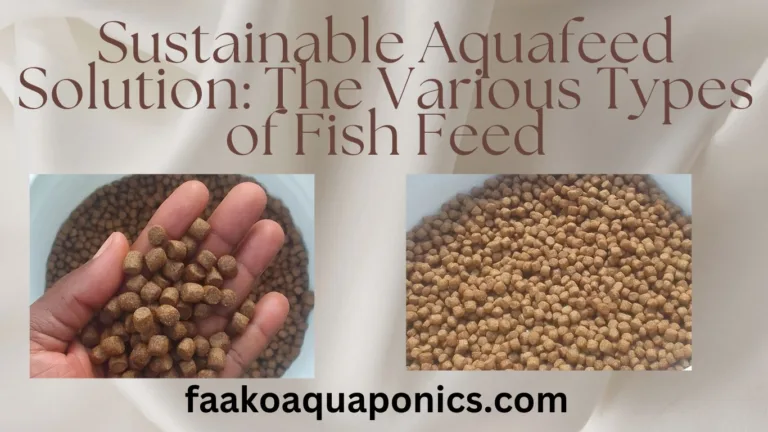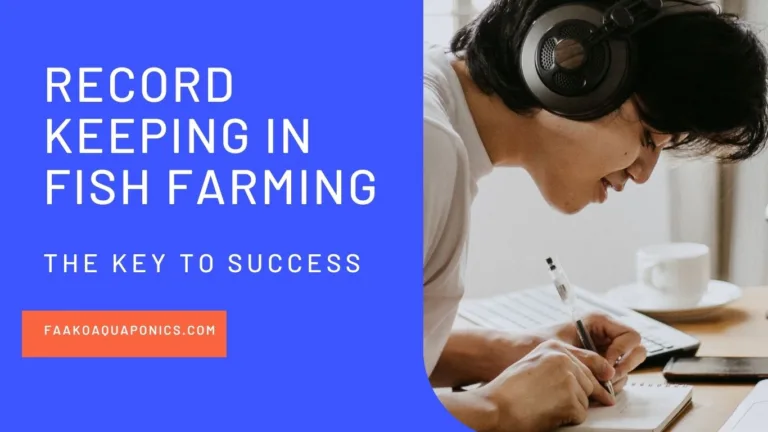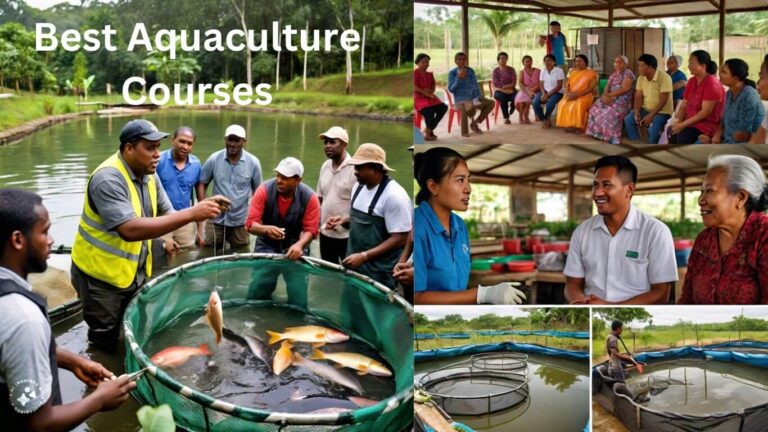In the world of aquaculture, achieving optimal growth and health in farmed fish relies heavily on the formulation of fish feed and balanced diets. Central to this process are processed feed ingredients – the building blocks of aquafeed formulations.
These ingredients undergo processing methods to ensure they deliver the necessary nutrients for fish while also considering sustainability concerns.
The Importance of Processed Feed Ingredients
Processed feed ingredients are the backbone of aquafeed formulations, providing essential nutrients such as proteins, lipids, carbohydrates, vitamins, and minerals.
From fishmeal to soybean meal, each ingredient is carefully selected and processed to meet the specific dietary requirements of different fish species and life stages.
This meticulous approach ensures that farmed fish receive a balanced diet that supports growth, health, and overall performance.
Advantages of Processed Feed Ingredients
One of the key advantages of processed feed ingredients is their nutritional balance. By combining a variety of ingredients, aquafeed manufacturers can create feeds tailored to meet the precise nutritional needs of farmed fish.
These ingredients also offer high protein content, essential for muscle development and growth.
Additionally, processed feed ingredients undergo rigorous quality control measures to maintain consistency and purity, ensuring that each batch meets the highest standards of safety and efficacy.
Types of fish feed
1. Pelleted Fish Feed
Pelleted feed refers to a type of fish feed that is processed into small, cylindrical pellets. These pellets are formulated to provide balanced nutrition to fish and are widely used in aquaculture operations.
Composition and Production of Pelleted Fish Feed
Pelleted feed is typically made using a process called pelleting. The process involves grinding raw ingredients such as fishmeal, soybean meal, grains, vitamins, and minerals into a fine powder.
This powder is then mixed with water or other binding agents to form a dough-like consistency. The mixture is then forced through a pellet mill, where it is extruded through a die with small holes under high pressure and temperature. As the mixture passes through the die, it forms pellets of the desired size and shape.
The pellets are then dried to reduce moisture content and increase durability before being packaged for distribution.
The feed is pelleted into different sizes depending on the size and type of fish to feed. The size varies, from 1.0mm to 8.0mm
Advantages of Pelleted Fish Feed
1. Nutritional Balance
The pelleted feed can be formulated to provide a balanced diet that meets the specific nutritional requirements of different fish species and life stages.
2. Convenience
Pelleted feed is easy to handle, store, and transport compared to other types of feed such as live feed or powdered feed.
3. Reduced Waste
The Pelleted feed tends to have less waste compared to other forms of feed, as fish are less likely to selectively feed or scatter the pellets.
4. Controlled Feeding
Pellets can be engineered to float or sink, allowing for controlled feeding depending on the species and feeding behavior of the fish.
5. Uniformity
Pelleted feed offers consistency in size, shape, and nutrient composition, ensuring that fish receive a consistent diet with each feeding.
Disadvantages of Pelleted Fish Feed
1. Processing Cost
The production of pelleted feed requires specialized equipment and processes, which can increase production costs compared to other forms of feed. The pelleting machine, extruders, and other equipment involved are costly. Also, it involved electricity which is costly.
2. Moisture Sensitivity
Pellets can absorb moisture if not stored properly, leading to spoilage or degradation of the feed quality. This spoiled feed can also cause fish mortality when fed your fish with
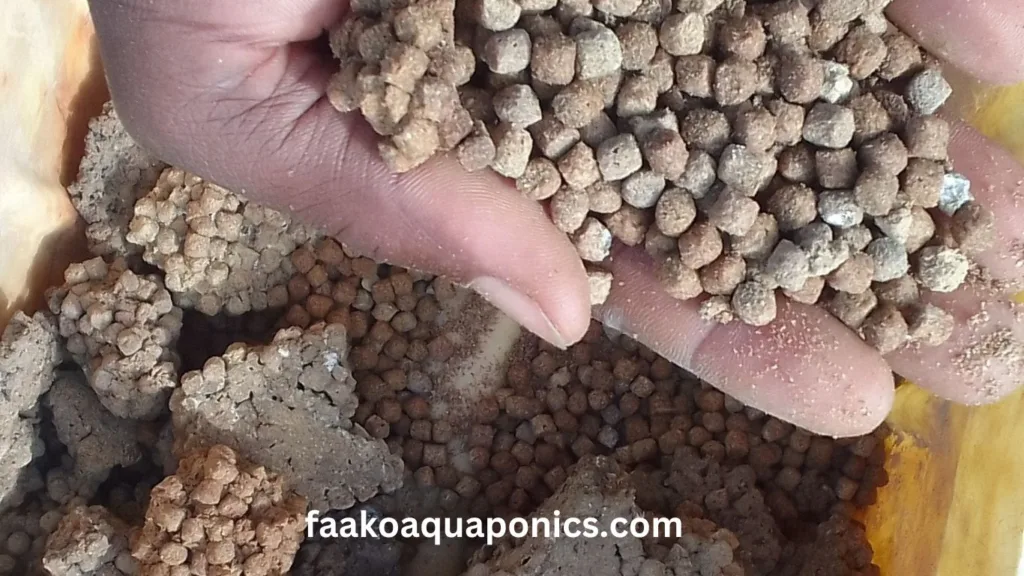
spoiled pelleted feed due to poor storage
3. Limited Palatability
Some fish species may have preferences for certain feed types or textures, and pelleted feed may not always be the most palatable option.
4. Nutrient Loss
During the pelleting process, heat-sensitive nutrients such as vitamins and enzymes may be degraded, reducing the overall nutritional value of the feed.
5. Environmental Impact
The production of pelleted feed may involve the use of energy-intensive processes and the generation of by-products or waste materials, contributing to environmental concerns if not managed properly.
Remarks on Pelleted Fish Feed
Overall, pelleted feed remains a popular choice in aquaculture due to its convenience, nutritional benefits, and ease of handling, despite some inherent disadvantages associated with its production and use.
2. Extruded Fish Feed
Extruded feed is a type of fish feed that undergoes a processing method known as extrusion. Extrusion involves forcing a mixture of ingredients through a die under high pressure and temperature, resulting in a continuous stream of feed with a uniform shape and size.
Composition and Production
Extruded feed is typically composed of ingredients such as fishmeal, soybean meal, grains, vitamins, minerals, and additives.
The ingredients are ground into a fine powder and then mixed with water or steam to form a dough-like consistency.
This mixture is then fed into an extruder, which consists of a barrel with a rotating screw. As the mixture moves through the barrel, it is subjected to high pressure and temperature, causing the ingredients to cook and expand. The feed is forced through a die at the end of the extruder, where it is cut into uniform pieces by rotating knives.
These pieces are then dried to reduce moisture content and increase shelf stability before being packaged for distribution.
Advantages of Extruded Fish Feed
1. Improved Digestibility
The extrusion process can improve the digestibility of feed ingredients, making nutrients more readily available to the fish and potentially improving feed conversion ratios.
2. Uniformity
Extruded feed offers uniformity in size, shape, and nutrient composition, ensuring consistent feeding and growth rates among fish.
3. Enhanced Palatability
The extrusion process can enhance the palatability of feed by improving texture, flavor, and aroma, making it more attractive to fish.
4. Reduced Waste
Extruded feed tends to have less waste compared to other forms of feed, as fish are less likely to selectively feed or scatter the pellets.
5. Controlled Feeding
Extruded feed can be engineered to float or sink, allowing for controlled feeding depending on the species and feeding behavior of the fish.
Disadvantages Extruded Fish Feed
1. Processing Cost
The production of extruded feed requires specialized equipment and processes, which can increase production costs compared to other forms of feed.
2. Nutrient Loss
During the extrusion process, heat-sensitive nutrients such as vitamins and enzymes may be degraded, reducing the overall nutritional value of the feed.
3. Energy Intensive
The extrusion process requires significant energy input such as electricity to achieve high pressure and temperature conditions, contributing to production costs and environmental impact.
4. Limited Flexibility
Extruded feed formulations may be less flexible compared to other types of feed, as the extrusion process requires ingredients with specific physical and chemical properties.
5. Storage Requirements
Extruded feed may require careful storage conditions to prevent moisture absorption and maintain shelf stability, which can add complexity to handling and storage logistics.
Remarks on Extruded Fish Feed
Overall, extruded feed offers several advantages in terms of improved digestibility, uniformity, palatability, and reduced waste.
But it also comes with certain disadvantages related to production costs, nutrient loss, energy consumption, and storage requirements.
3. Powdered Fish Feed
Powdered feed refers to a type of fish feed that is finely ground into a powder-like consistency. It is commonly used for feeding fry (young fish) or species that require small particle sizes. The powdered feed can be mixed with water to form a paste or slurry for feeding.
Composition and Production of Powdered Fish Feed
The powdered feed is typically composed of a variety of ingredients such as fishmeal, soybean meal, grains, vitamins, minerals, and additives.
These ingredients are ground into a fine powder using grinding equipment such as hammer mills or pulverizers. The resulting powder is then carefully mixed to ensure uniform distribution of nutrients before being packaged for distribution.
Some powdered feeds may also undergo additional processing steps, such as micronization or pelletization, to further refine the particle size and improve digestibility.
Advantages of Powdered Fish Feed
1. Suitable for Fry and Small Fish
Powdered feed is ideal for feeding fry and small fish that require small particle sizes for efficient digestion and nutrient uptake.
2. Ease of Digestion
The fine particle size of powdered feed facilitates rapid digestion and absorption of nutrients, promoting growth and development in young fish.
3. Uniform Nutrient Distribution
Powdered feed can be easily mixed with water to form a homogeneous slurry, ensuring consistent nutrient intake among fish.
4. Flexible Feeding Methods
Powdered feed can be administered through various feeding methods, including hand-feeding, automatic feeders, or feeding trays. Allowing for flexibility in feeding strategies.
5. Reduced Waste
Since powdered feed can be easily consumed by fish without selective feeding. It tends to result in less waste compared to larger feed particles.
Disadvantages of Powdered Fish Feed
1. Handling Challenges
Powdered feed can be difficult to handle and store due to its fine particle size, which can lead to dusting, clumping, and issues with flowability.
2. Water Quality Concerns
When mixed with water, powdered feed can contribute to water quality issues such as cloudiness, sedimentation, nutrient accumulation, and water oxygen reduction if not properly managed.
3. Feeding Efficiency
Powdered feed may not be as efficient as pelleted or extruded feed in terms of feed conversion ratios, as some nutrients may be lost during handling and feeding.
4. Limited Use
Powdered feed may not be suitable for all fish species or life stages, as some larger or carnivorous fish may require larger feed particles or whole prey items for optimal nutrition.
5. Nutrient Degradation
The grinding process used to produce powdered feed may result in the degradation of heat-sensitive nutrients such as vitamins and enzymes, reducing the overall nutritional quality of the feed.
Remarks on Powdered Fish Feed
Overall, powdered feed offers advantages in terms of suitability for fry and small fish, ease of digestion, and uniform nutrient distribution, but it also comes with challenges related to handling, water quality, feeding efficiency, and nutrient degradation.
Proper management and feeding practices are essential to maximize the benefits of powdered feed while minimizing potential drawbacks.
4. Floating Feed
Floating feed is a type of fish feed that is formulated to float on the water’s surface, making it easier for fish to locate and consume. This type of feed is commonly used in pond culture and for species that prefer to feed near the surface.
Composition and Production of Floating Feed
Floating feed is typically composed of ingredients such as fishmeal, soybean meal, grains, vitamins, minerals, and additives. The ingredients are ground into a fine powder and then mixed with water or steam to form a dough-like consistency.
This mixture is then extruded or pelleted using specialized equipment to create feed pellets with a lower density compared to sinking feed.
The pellets are designed to contain air pockets or buoyant materials that enable them to float on the water’s surface without immediately sinking.
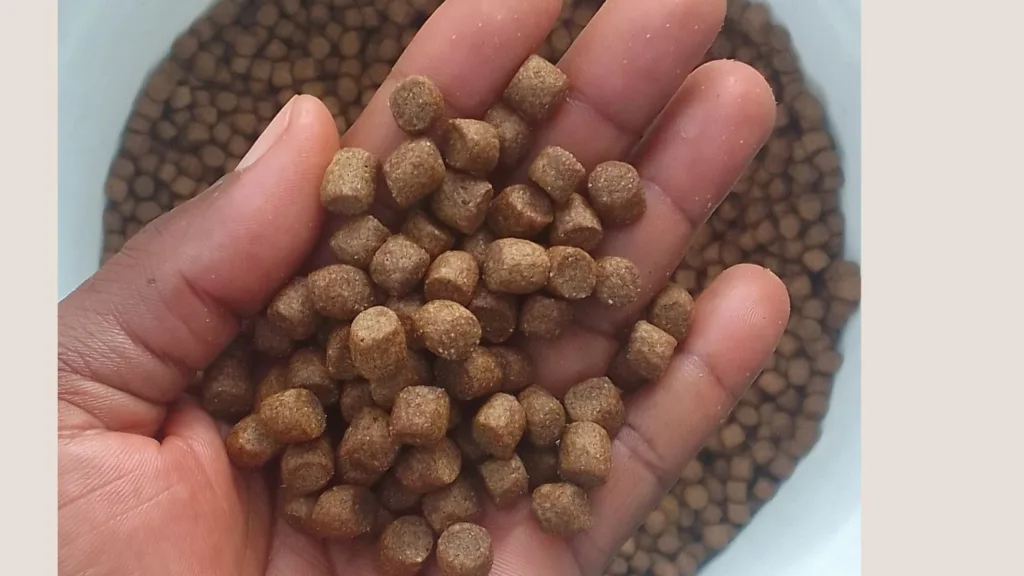
8.0mm floating fish feed
Advantages of Floating Feed
1. Surface Feeding
Floating feed allows fish to feed at the water’s surface, making it easier for them to locate and consume the feed.
2. Reduced Waste
Since floating feed remains on the water’s surface, it is less likely to be lost or wasted compared to sinking feed, which can sink to the bottom of the pond and become inaccessible to fish.
3. Improved Visibility
The floating nature of the feed makes it more visible to fish, especially in outdoor pond systems where natural light may vary throughout the day.
4. Controlled Feeding
This makes it easy for the fish farmer to monitor whether the fish are really eating or not. In that way, you can tell whether the fish are all right or there is something wrong. Because healthy fish have high appetites and through that, you can monitor them.
5. Reduced Risk of Water Contamination
Floating feed minimizes contact with the pond bottom, reducing the risk of contamination from sediment or other pollutants.
It only contaminates the water when you give them more than required and they then eat and leave the remaining to dissolve in the water. That is why you should always use the responsive method of feeding your fish.
The responsive method is through into the pond at a lower speed and quantity and observing how they are reacting to the feed. This method also ensures you do not overfeed your fish
Disadvantages of Floating Feed
1. Susceptibility to Environmental Factors
Floating feed may be affected by factors such as wind, water currents, and temperature fluctuations, which can cause it to drift or disperse unevenly across the water’s surface.
2. Limited Depth Range
Floating feed is only suitable for species that feed near the water’s surface, and may not be accessible to species that prefer to feed at deeper depths.
3. Palatability Issues
Some fish species may be less inclined to consume floating feed compared to sinking feed, particularly if they are accustomed to feeding on natural prey items or bottom-dwelling organisms.
4. Feed Loss
Floating feed may be prone to loss due to factors such as birds, insects, or other wildlife consuming the feed before fish have a chance to feed on it.
5. Handling Challenges
Floating feed pellets may be more fragile and prone to breakage compared to sinking pellets, making them more challenging to handle and transport without damage.
Remarks on Floating Feed
Overall, floating feed offers advantages in terms of surface feeding, reduced waste, improved visibility, controlled feeding, and reduced risk of water contamination, but it also comes with certain disadvantages related to environmental susceptibility, depth limitations, palatability issues, feed loss, and handling challenges. Proper management and feeding practices are essential to maximize the benefits of floating feed while minimizing potential drawbacks.
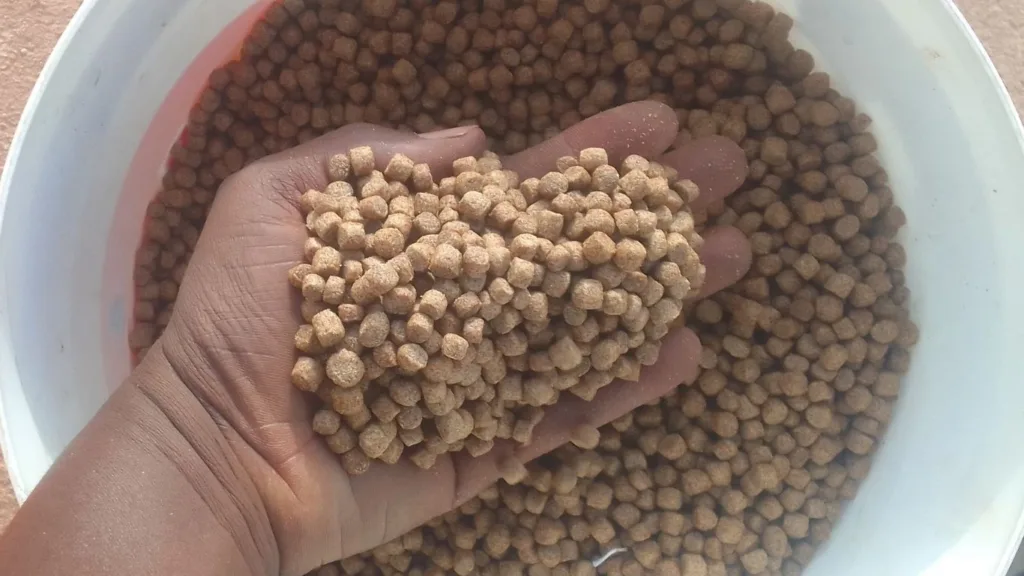
6.0mm floating fish feed
5. Sinking Fish Feed
Sinking feed is a type of fish feed that is formulated to sink to the bottom of the water column. It is designed for species that prefer to feed at deeper depths or for use in tanks or cages where fish feed at different levels.
Composition and Production
Sinking feed is composed of ingredients similar to other types of fish feed, including fishmeal, soybean meal, grains, vitamins, minerals, and additives.
The ingredients are ground into a fine powder and mixed together with water or steam to form a dough-like consistency.
This mixture is then extruded or pelleted using specialized equipment to create feed pellets with a higher density compared to floating feed.
The pellets are designed to sink rapidly to the bottom of the water column, where they are accessible to bottom-feeding species or fish in tanks or cages.
Advantages of Sinking Fish Feed
1. Suitable for Bottom-Feeding Species
Sinking feed is ideal for species that naturally feed at deeper depths or prefer to feed on the bottom of the water column.
2. Reduced Competition
Sinking feed can help reduce competition for food among fish species with different feeding habits, as bottom feeders can access the feed without interference from surface feeders.
3. Less Susceptible to Environmental Factors
Sinking feed is less affected by factors such as wind, water currents, and temperature fluctuations compared to floating feed, as it remains confined to the bottom of the water column.
4. Minimized Feed Loss
Sinking feed is less prone to loss due to factors such as birds, insects, or other wildlife consuming the feed before fish have a chance to feed on it.
5. Controlled Feeding
Sinking feed can be easily distributed to specific areas of the pond, tank, or cage, allowing for precise control over feeding rates and locations.
Disadvantages of Sinking Fish Feed
1. Limited Access for Surface-Feeding Species
Sinking feed may not be accessible to species that prefer to feed near the water’s surface, limiting its usefulness in mixed-species aquaculture systems.
2. Potential Accumulation of Feed
Sinking feed may accumulate on the pond or tank bottom if not consumed by fish, leading to waste buildup and water quality issues.
3. Reduced Visibility
Sinking feed may be less visible to fish compared to floating feed, especially in turbid or densely stocked aquaculture systems, which could affect feeding efficiency.
4. Handling Challenges
Sinking feed pellets may be more prone to breakage during handling and transport compared to floating pellets, requiring careful management to prevent feed wastage and degradation.
5. Higher Risk of Overfeeding
Sinking feed may pose a higher risk of overfeeding, particularly in systems with poor water exchange or where feed distribution is not carefully monitored, leading to water quality problems and potential health issues for fish.
Remarks on Sinking Fish Feed
Overall, sinking feed offers advantages in terms of suitability for bottom-feeding species, reduced competition, environmental resilience, minimized feed loss, and controlled feeding, but it also comes with certain disadvantages related to limited access for surface feeders, potential feed accumulation, reduced visibility, handling challenges, and the risk of overfeeding.
Proper management and feeding practices are essential to maximize the benefits of sinking feed while minimizing potential drawbacks.
6. Live Feed
Live feed refers to organisms that are cultured and fed directly to fish. These organisms are typically small in size and may include species such as brine shrimp, daphnia, rotifers, copepods, or various types of larvae.
Live feed is commonly used for feeding larval and juvenile stages of fish, as it closely mimics their natural diet and helps promote growth and development.
Composition and Production of Live Feed
Live feed organisms are typically cultured in controlled environments such as hatcheries or aquaculture facilities. The production process varies depending on the species being cultured. Generally involves providing suitable environmental conditions, such as temperature, light, water quality, and nutrition, to support growth and reproduction.
Live feed cultures may be maintained in tanks, ponds, or specialized culture vessels and fed a diet of algae, yeast, or other suitable food sources to promote growth and reproduction.
Advantages of Live Feed
1. Nutritional Quality
Live feed organisms provide high-quality nutrition that closely resembles the natural diet of fish, containing essential proteins, lipids, vitamins, and minerals required for growth and development.
2. Stimulates Natural Feeding Behaviors
Live feed encourages natural feeding behaviors in fish, promoting active foraging and hunting instincts, which can enhance growth rates and survival.
3. High Digestibility
Live feed organisms are easily digestible and readily absorbed by fish, maximizing nutrient uptake and utilization.
4. Promotes Growth and Development
Live feed is particularly beneficial for feeding larval and juvenile stages of fish, as it provides essential nutrients and energy needed for rapid growth and development.
5. Enhanced Immune System
Live feed organisms contain beneficial microorganisms and bioactive compounds that can help support the immune system and enhance disease resistance in fish.
Disadvantages of Live Feed
1. Labor Intensive
Culturing live feed organisms can be labor-intensive and time-consuming, requiring regular maintenance, monitoring, and management of culture conditions.
2. Costly
Live feed production can be expensive, as it requires investment in infrastructure, equipment, and operational expenses such as feed and utilities.
3. Limited Shelf Life
Live feed organisms have a limited shelf life and must be used promptly to maintain viability and nutritional quality, posing challenges for storage and transportation.
4. Risk of Disease Transmission
Live feed cultures may harbor pathogens or parasites that can infect fish, posing a risk of disease transmission if proper biosecurity measures are not implemented.
5. Variable Nutrient Composition
The nutrient composition of live feed organisms can vary depending on factors such as culture conditions, age, and diet, making it challenging to achieve consistent feeding and nutritional outcomes.
Remarks on Live Fish Feed
Overall, live feed offers advantages in terms of nutritional quality, stimulation of natural feeding behaviors, growth promotion, and immune system support. It also comes with challenges related to labor intensity, cost, shelf life, disease risk, and variability in nutrient composition.
Proper management practices and biosecurity measures are essential to maximize the benefits of live feed while minimizing potential drawbacks.
7. Processed Feed Ingredients
Processed feed ingredients refer to individual ingredients used in formulating complete fish feeds. These ingredients undergo various processing methods to enhance their digestibility, nutrient content, and suitability for inclusion in fish feed formulations.
Processed feed ingredients are essential components of balanced diets for fish and are used to provide essential nutrients such as proteins, lipids, carbohydrates, vitamins, and minerals.
Composition and Production
Processed feed ingredients can include a wide range of raw materials sourced from both marine and terrestrial sources. Common processed feed ingredients used in aquafeed formulations include fishmeal, fish oil, soybean meal. Wheat flour, corn gluten meal, rice bran, poultry meal, and various by-products from food processing industries.
These ingredients undergo processing methods such as grinding, cooking, drying, and extrusion to improve their nutritional quality, digestibility, and palatability.
For example, fishmeal is produced by grinding and cooking whole fish or fish by-products, while soybean meal is obtained by solvent extraction of soybeans. This is Followed by heat treatment to remove anti-nutritional factors.
Advantages of Processed Feed Ingredients
1. Nutritional Balance
Processed feed ingredients can be selected and combined to create balanced diets that meet the specific nutritional requirements of different fish species and life stages.
2. High Protein Content
Many processed feed ingredients, such as fishmeal and soybean meal, are rich sources of high-quality proteins essential for growth and muscle development in fish.
3. Diverse Nutrient Profile
Processed feed ingredients provide a diverse array of nutrients, including essential amino acids, fatty acids, vitamins, and minerals, to support overall health and well-being in fish.
4. Consistency and Quality Control
Processed feed ingredients undergo standardized processing methods to ensure consistent quality, purity, and safety, reducing the risk of variability and contamination in aquafeed formulations.
5. Availability and Accessibility
Processed feed ingredients are widely available from commercial suppliers and can be easily sourced to meet the nutritional requirements of fish farming operations worldwide.
Disadvantages of Processed Feed Ingredients
1. Cost
Some processed feed ingredients, particularly high-quality protein sources like fishmeal, can be expensive, contributing to the overall cost of feed production.
2. Environmental Impact
The production of processed feed ingredients, particularly those derived from marine sources such as fishmeal and fish oil. These can have environmental consequences such as overfishing, habitat degradation, and depletion of natural resources.
3. Sustainability Concerns
There are concerns about the sustainability of certain processed feed ingredients, particularly those sourced from wild fisheries. This intends to promote the use of alternative protein sources and reduce reliance on finite resources.
4. Anti-Nutritional Factors
Some processed feed ingredients may contain anti-nutritional factors or contaminants that can negatively impact fish health and performance if not properly processed or managed.
5. Dependency on External Sources
Fish farming operations may become dependent on external suppliers for processed feed ingredients, which can pose logistical challenges, supply chain risks, and vulnerability to market fluctuations.
Remarks on Processed Feed Ingredients
Overall, processed feed ingredients play a crucial role in formulating complete fish feeds, providing essential nutrients, and supporting growth and development in farmed fish.
However, their use comes with considerations related to cost, environmental impact, sustainability, quality control, and dependency on external sources.
Efforts to promote sustainable sourcing practices, optimize feed formulations, and explore alternative ingredients. All these are important for addressing these challenges and advancing the sustainability of aquaculture.
Conclusion
In conclusion, the future of aquaculture depends on sustainable solutions in fish feed technology. By embracing alternative protein sources, optimizing nutritional profiles, adopting sustainable production methods. Also, leveraging technological innovations, and fostering collaboration you can grow your fish bigger.
The aquaculture industry can address environmental challenges and meet the growing global demand for seafood responsibly and sustainably.
Through continued innovation and collective action, we can ensure a successful future for both the aquaculture industry and the planet.


